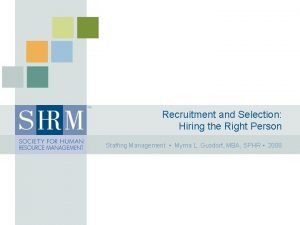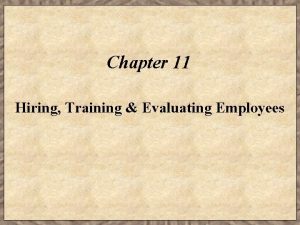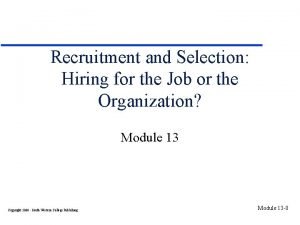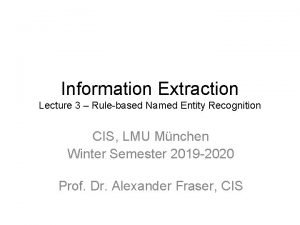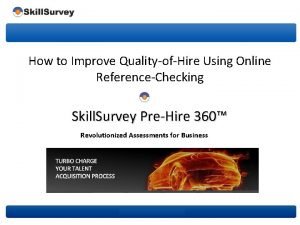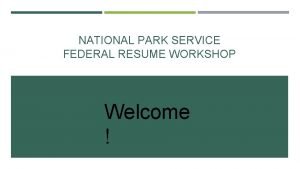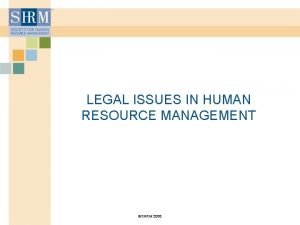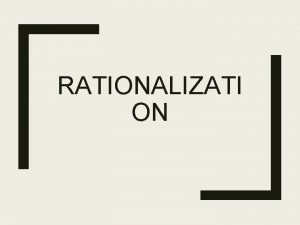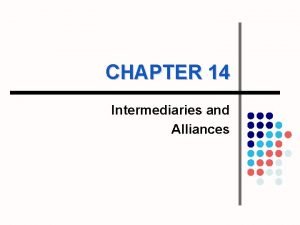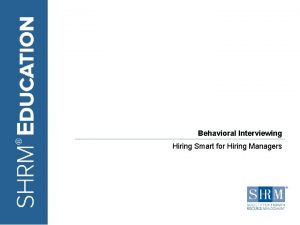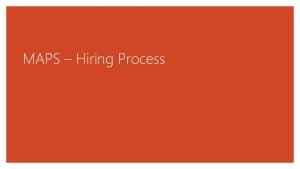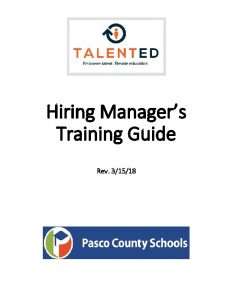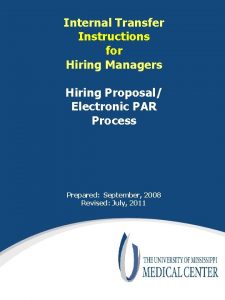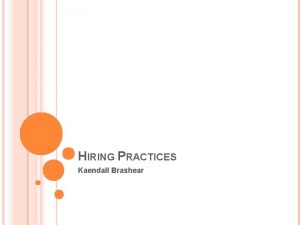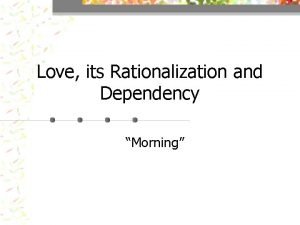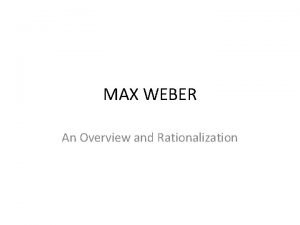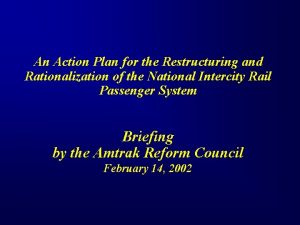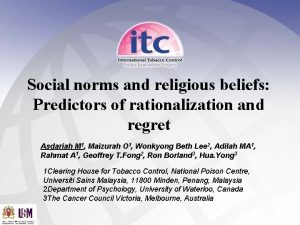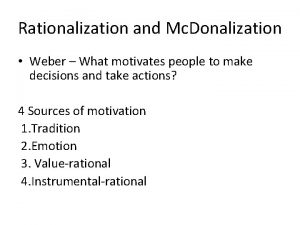THE RATIONALIZATION OF HIRING ALGORITHMS INTERMEDIARIES AND INFORMATION

















- Slides: 17

THE RATIONALIZATION OF HIRING: ALGORITHMS, INTERMEDIARIES, AND INFORMATION • DAVID B. BILLS, UNIVERSITY OF IOWA • DAVID-BILLS@UIOWA. EDU • PREPARED FOR JANUARY 2020 MEETING OF NCRN, WASHINGTON DC

THE SHIFTING BALANCE OF INTERNAL AND EXTERNAL HIRING AND THE FLEXIBILIZATION OF LABOR MARKETS • Demise of ILMs (from closed to open employment relationships) • Externalization of Hiring – employers in the United States filled only about 10% of their vacancies from the outside in the period from World War II to the 1980 s, current evidence suggests that they now fill over 60% of vacancies from outside. ”

THE RATIONALIZATION OF HIRING • The digitalization of the hiring process – Big Data, analytics, work-force science, robotic recruitment, People Ops, etc Triadic labor market relationships (LMIs, e. g. , recruiters, headhunters, staffing agencies, etc. )

• Hiring is now often a relationship not principally between an employer and a job seeker, but rather a relationship shaped and even made by an algorithm, a set of automated decision rules that augment or even replace human decision making. As the locus of hiring shifts away from a specific manager, the agency of the demand side shifts from the human to the machine.

IS THIS REAL? IS IT WIDESPREAD? • No good estimates, but…. • Most hiring activity now involves the internet in one way or another (well over 80%, in 2015 28% of US job seekers used their smartphone to look for work) • Labor market intermediaries are ubiquitous • Although the term “applying for a job” has become kind of quaint, when “apply” is just “press enter” – Starbucks gets nearly 120 “applications” for every opening • The “passive candidate” • "I kind of wonder if some of the jobs I'm applying to even exist, " says Asa Denton, a 31 -year-old software programmer in Reno, Nev. , who has been job hunting for four months. •

RATIONALIZATION BOTH SOLVES AND CREATES INFORMATIONAL PROBLEMS OF TRUST • Visible credentials advantage job seekers. As job seekers have to compete for jobs from the outside, they lose the opportunity to have organizational gatekeepers directly observe and reward their performance. • Employers have to find ways to secure information that they trust and fill openings when they cannot rely on first-hand observation.

DOES ALL OF THIS REDUCE LABOR MARKET FRICTIONS? • This is a bigger problem for job seekers than for employers. • Employers can amass more information than ever before (even if it’s not direct observation). • Job seekers unsure about what signals are being sought, or how to send them. Individuals at the point of application for a job may not be entirely or even vaguely aware of the role of algorithms in shaping their opportunities. • But if workers hired from the outside need stronger visible credentials than those hired from inside, how do they identify, acquire, and signal these credentials?

• Briefly, how can job seekers negotiate Applicant Tracking Software? • With still more LMIs - Programs like Wordle, Tag. Crowd, and The Muse designed to help job seekers optimize their resumes to match soughtafter keywords (Resume Optimization, or RO) • Mastery of keywords as a post-ILM skill

SO TWO QUESTIONS • Demand Side Question - How does the rationalization of hiring affect the recruitment and selection practices of employers? • Supply Side Question- How does the rationalization of hiring affect the search behaviors of workers?

SO HOW DO WE FIND OUT? • Something of a crisis in collecting data on hiring. • Employers (both HR and hiring managers) have ceded control and discretion to the algorithms (which, incidentally, make better hiring decisions (as do personality tests, credit reports, and even video game performance)) • The LMIs are protective and secretive about their algorithms • Employers seem less open to opening their practices to social scientists (especially because HR managers stand to be the biggest losers from rationalized hiring – Mc. Donald et al (2019))

THE EMERGENCE OF BIG DATA: SCRAPING, DUCK-TYPING, AND THE ZEN OF PYTHON Great promise (Lenaerts et al 2016) but…… Lazer and Radford (2017) “digital archives are not the product of scientific design. The information captured in these archives is not what a social scientist would choose”. “massive passive data”

• predictive (descriptive) models versus explanatory models – massive and passive does not obviate the need for theory • Can’t look at aspirations, goals, etc. - throws out the social psychology of search • • Sheer scale does not eliminate problems of selection and generalizability – seem in a rush to abandon what we know of sampling theory and inferential statistics •

• Also, we’re perhaps learning more about internet (gig economy) jobs than we are about employer jobs (e. g. , Leung’s excellent study of contract workers using Elance. com – this study shows how difficult it is to take on-line data collected for non-research purposes and make sense of it)

• What does all of this mean for Non-Degree Credentials? – Ideally, NDC’s will be information-rich, presumably signaling real competencies and not just seat time – Algorithms select on (among other things) social media footprint, facial tics, opaque keywords (software/coding, specific school, job task), an affinity with a particular Japanese Manga web page (true story), – Need to solve signal to noise problems – how to get employers’ attention given the unprecedented volume of information now available to them.

• Thank you for your attention • david-bills@uiowa. edu

“THE QUALITY, CONSISTENCY, ACCURACY AND VOLATILITY OF WEB DATA SHOULD BE EXAMINED” (LENAERTZ ET AL. 2016) Until we develop and agree upon some standards, we’re sort of in the dark about some things. We often don’t know very much about the measurement properties of the sample/population, self-selection, psychometrics of the items, etc. (not like we do for sample surveys) “Our work contributes to a growing field on the use of online data sources and is distinctive in its analysis of a range of skills and abilities and its systematic comparative approach. The results need to be considered with caution, however, because their usage is conditioned on an in-depth investigation of representativeness and reliability of online vacancies (Edelman 2012; Sappleton 2013), which we are unable to conduct in this article. ” (Kurekova et al. 2015).

Researchers need to become as conversant with the nuances of Glassdoor, Monster, and Pymetrics as they are now with NLSY, PSID, and CPS Also, what do significance tests mean when we’re dealing with populations? Or when we don’t know what population our sample represents?
 Information retrieval data structures and algorithms
Information retrieval data structures and algorithms Signature file structure in information retrieval system
Signature file structure in information retrieval system Similarities of recruitment and selection
Similarities of recruitment and selection Selection in staffing
Selection in staffing Hiring training and evaluating employees
Hiring training and evaluating employees Difference between hiring and recruitment
Difference between hiring and recruitment The financial system
The financial system Information extraction algorithms
Information extraction algorithms Skill survey healthcare hiring
Skill survey healthcare hiring Recruitment process stages
Recruitment process stages City of los angeles targeted local hire
City of los angeles targeted local hire Targeted local hire program
Targeted local hire program Geico hiring process 2020
Geico hiring process 2020 Campus hiring
Campus hiring Public land corps hiring authority
Public land corps hiring authority Negligent hiring in hrm
Negligent hiring in hrm Ameren hiring process
Ameren hiring process Uab background
Uab background



